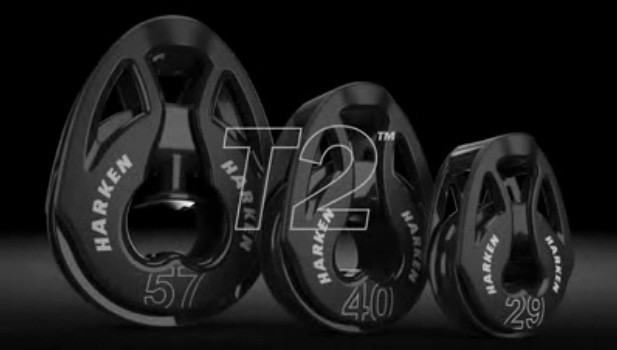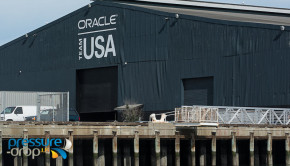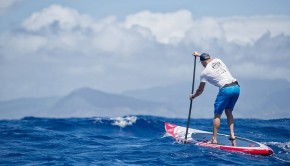Technical Review – Softies
Published on August 31st, 2012
Remember shackles? How about ring dings? So yesterday! Mike Lee from Harken Technical Service explains how we have progressed all the way back to the beginning.
Soft attachment sounds as exciting as sewing a button back on to your favorite sweater vest; however, it is the latest high-tech trend in the sailing industry. But clever engineers cannot run away with all the credit. It really wasn’t their idea in the first place. They only improved on an old idea.
Back in the days of iron men and wooden ships, blocks were attached with rope in lieu of costly shackles and headposts which also needed to be forged and shaped by a Smith. Today, shackles and headposts have been eliminated to save weight. “What’s old in sailing is now new”.

Stronger than Steel
The creation of soft attachments for highly-loaded blocks really started when line manufactures began introducing fibers that were amazingly strong; 5 mm line that could lift an angry rhinoceros. Dyneema® and Spectra® are a sailor’s dream lines: 15 times stronger than steel, absorb almost no water, 28% lighter than polyester line, and UV resistant. Other than cost, what more could a sailor possibly want?
Shackles Equal Weight
When dozens of shackles quickly added up to significant weight increases on race boats that will go to the ends of the earth to trim even a gram, shackle-less blocks began to appear. With the introduction of the standard Black Magic® line in the mid-90s, Harken® created a block nicknamed “The Web-Head”. In the beginning, the problem with using a webbed-on block was there was no easy way to attach it without getting a rigger involved to web and sew it permanently in place. In sailing, especially in racing, everything needs to be tweaked on the water to get the best performance. But with a shackle-less block, forever webbed in place, there was no tweaking without starting over again with needle and thread. Convenience was sacrificed if savings weight was important.
While other companies were coming out with their interpretations of lashed-on blocks, Harken arrived on the scene with a simple soft-attach block; the 57mm Ti-Lite. They figured that since line can be used to tie things to other things, why not tie a block to the boat rather than use a heavy shackle. The block came with a plain 3 mm yellow piece of Spectra® line along with a hex key to tighten the set screw securing the line.

Side Benefits
There are a few important side benefits other than weight savings. When lashed on, a block will always articulate allowing the load to be perfectly aligned, making the block more efficient. In addition, there was the realization that the block no longer needed to be attached to an eyestrap; anywhere a sailor could get the Spectra® wrapped around, such as a boom, was fair game.
Darwin
Evolution was taking place with straphead blocks and with the development of loops which didn’t required a long needle, a sailor’s palm, or hours of aggravation.
When seen for the first time, a loop is a wolf in sheep’s clothing. It looks like nothing more than a simple rope ring from a ring toss game. Yet the 12 mm Yale LOUP® has a maximum working load of 7,200 lb. Blocks evolved so loops could be used as easily as a shackle pin.
Shortly after, Harken started dabbling with blocks that were nothing more than a sheave with a hole in the middle to run the loop through. It didn’t take long to realize this wasn’t going to work. The blocks would “capsize” and the line would jam tight between the loop and sheave. Designs changed fast at Harken Custom and the next sheaves had simple “stabilizing” sideplates to weave the loop through. These sideplates worked well until the top cross piece blew out. On a block that had done just that, Peter Harken was seen at the Harken service trailer in Key West drilling two small holes below where the missing cross piece had been, and using a small piece of Spectra™ to lash the loop to the sideplate. VOILA! The modern loop block had arrived.

Soft Attachment Arrives
Fast forward many years, as “web attached” blocks were pushed to the side and soft-attachment blocks, with the same convenience as a shackle, took their place. In most cases, the blocks are designed to run a loop over a dead-end post, making the block quick and easy to attach. Harken—always pushing the limits to make better and lighter hardware—added soft-attachment blocks for almost every size boat; T2™ for smaller boats and lighter loads, Black Magic® Big Boat Loop blocks, and the semi-custom TTR AirBlocks® for very high loads. With the advancement of these blocks, any non-rigger can attach them effortlessly.
When looking at an uncomplicated modern soft-attach block, it is amusing to think it took more than a decade for them to evolve into what they are now, for they certainly look anything BUT high tech.
Spectra® is a registered trademark of Honeywell International, Inc. Dyneema® is a registered trademark of DSM Dyneema. LOUP® is a registered trademark of Yale Cordage.









 We’ll keep your information safe.
We’ll keep your information safe.